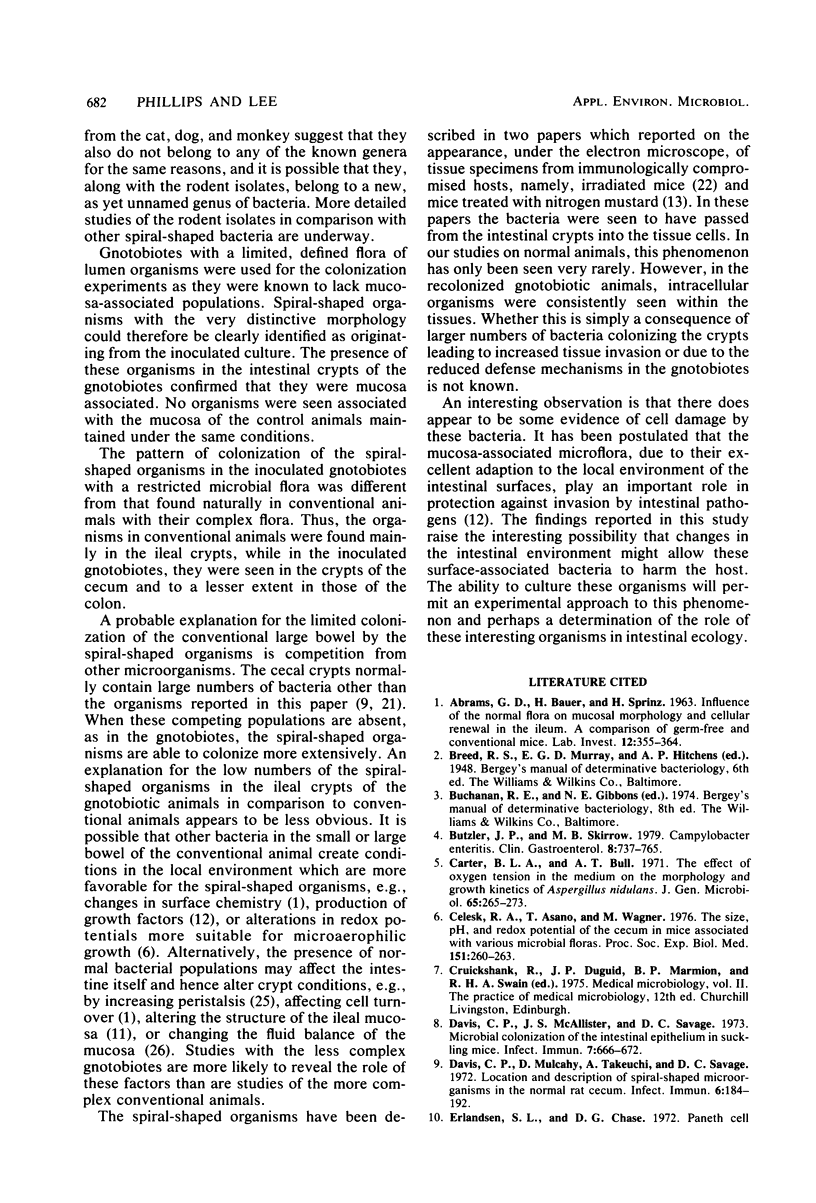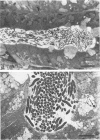Abstract
Spiral-shaped bacteria with a distinctive morphology were isolated from the intestinal mucosa of rats and mice on a campylobacter selective medium using microaerophilic incubation. These bacteria have been shown by other authors to be present in the intestinal tracts of several animal species but have not been cultured previously. The results of electron microscopic examinations and biochemical testing have shown that these organisms do not correspond to any known genus. Colonization experiments with pure cultures in gnotobiotic rodents have shown these bacteria to be mucosa associated, with a particular affinity for intestinal crypts. The pattern of colonization of the intestinal crypts in gnotobiotes known to be free of other mucosa-associated organisms differed from the colonization occurring in conventional animals that possess a normal mucosa-associated flora.
Full text
PDF








Images in this article
Selected References
These references are in PubMed. This may not be the complete list of references from this article.
- ABRAMS G. D., BAUER H., SPRINZ H. Influence of the normal flora on mucosal morphology and cellular renewal in the ileum. A comparison of germ-free and conventional mice. Lab Invest. 1963 Mar;12:355–364. [PubMed] [Google Scholar]
- Butzler J. P., Skirrow M. B. Campylobacter enteritis. Clin Gastroenterol. 1979 Sep;8(3):737–765. [PubMed] [Google Scholar]
- Celesk R. A., Asano T., Wagner M. The size pH, and redox potential of the cecum in mice associated with various microbial floras. Proc Soc Exp Biol Med. 1976 Feb;151(2):260–263. doi: 10.3181/00379727-151-39187. [DOI] [PubMed] [Google Scholar]
- Davis C. P., McAllister J. S., Savage D. C. Microbial colonization of the intestinal epithelium in suckling mice. Infect Immun. 1973 Apr;7(4):666–672. doi: 10.1128/iai.7.4.666-672.1973. [DOI] [PMC free article] [PubMed] [Google Scholar]
- Davis C. P., Mulcahy D., Takeuchi A., Savage D. C. Location and description of spiral-shaped microorganisms in the normal rat cecum. Infect Immun. 1972 Aug;6(2):184–192. doi: 10.1128/iai.6.2.184-192.1972. [DOI] [PMC free article] [PubMed] [Google Scholar]
- Erlandsen S. L., Chase D. G. Paneth cell function: phagocytosis and intracellular digestion of intestinal microorganisms. II. Spiral microorganism. J Ultrastruct Res. 1972 Nov;41(3):319–333. doi: 10.1016/s0022-5320(72)90072-x. [DOI] [PubMed] [Google Scholar]
- GORDON H. A., BRUCKNER-KARDOSS E. Effect of normal microbial flora on intestinal surface area. Am J Physiol. 1961 Jul;201:175–178. doi: 10.1152/ajplegacy.1961.201.1.175. [DOI] [PubMed] [Google Scholar]
- Gordon H. A., Pesti L. The gnotobiotic animal as a tool in the study of host microbial relationships. Bacteriol Rev. 1971 Dec;35(4):390–429. doi: 10.1128/br.35.4.390-429.1971. [DOI] [PMC free article] [PubMed] [Google Scholar]
- Hampton J. C. The effects of nitrogen mustard on the intestinal epithelium of the mouse. Radiat Res. 1967 Mar;30(3):576–589. [PubMed] [Google Scholar]
- Lee A., Phillips M. Isolation and cultivation of spirochetes and other spiral-shaped bacteria associated with the cecal mucosa of rats and mice. Appl Environ Microbiol. 1978 Mar;35(3):610–613. doi: 10.1128/aem.35.3.610-613.1978. [DOI] [PMC free article] [PubMed] [Google Scholar]
- Lockard V. G., Boler R. K. Ultrastructure of a spiraled microorganism in the gastric mucosa of dogs. Am J Vet Res. 1970 Aug;31(8):1453–1462. [PubMed] [Google Scholar]
- Luft J. H. Ruthenium red and violet. II. Fine structural localization in animal tissues. Anat Rec. 1971 Nov;171(3):369–415. doi: 10.1002/ar.1091710303. [DOI] [PubMed] [Google Scholar]
- Phillips M., Lee A., Leach W. D. The mucosa-associated microflora of the rat intestine: a study of normal distribution and magnesium sulphate induced diarrhoea. Aust J Exp Biol Med Sci. 1978 Dec;56(6):649–662. doi: 10.1038/icb.1978.73. [DOI] [PubMed] [Google Scholar]
- QUASTLER H., HAMPTON J. C. Effects of ionizing radiation on the fine structure and function of the intestinal epithelium of the mouse. I. Villus epithelium. Radiat Res. 1962 Dec;17:914–931. [PubMed] [Google Scholar]
- Roach S., Savage D. C., Tannock G. W. Lactobacilli isolated from the stomach of conventional mice. Appl Environ Microbiol. 1977 May;33(5):1197–1203. doi: 10.1128/aem.33.5.1197-1203.1977. [DOI] [PMC free article] [PubMed] [Google Scholar]
- Roach S., Tannock G. W. A note on the isolation of spiral-shaped bacteria from the caecum of mice. J Appl Bacteriol. 1979 Dec;47(3):521–525. doi: 10.1111/j.1365-2672.1979.tb01213.x. [DOI] [PubMed] [Google Scholar]
- Savage D. C., Dubos R. Alterations in the mouse cecum and its flora produced by antibacterial drugs. J Exp Med. 1968 Jul 1;128(1):97–110. doi: 10.1084/jem.128.1.97. [DOI] [PMC free article] [PubMed] [Google Scholar]
- Smibert R. M. The genus Campylobacter. Annu Rev Microbiol. 1978;32:673–709. doi: 10.1146/annurev.mi.32.100178.003325. [DOI] [PubMed] [Google Scholar]
- WEBER A. F., SCHMITTDIEL E. F. Electron microscopic and bacteriologic studies of spirilla isolated from the fundic stomachs of cats and dogs. Am J Vet Res. 1962 May;23:422–427. [PubMed] [Google Scholar]





